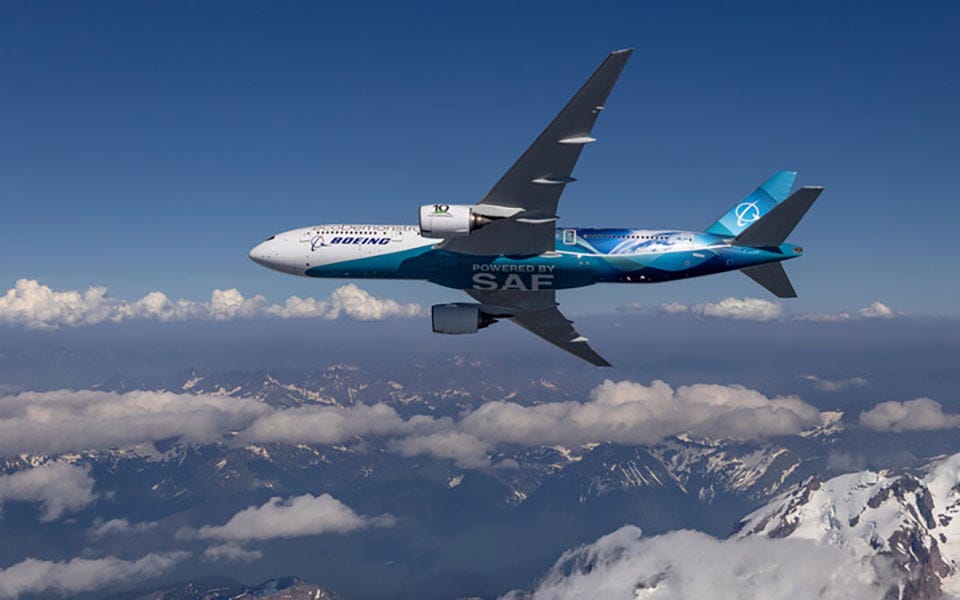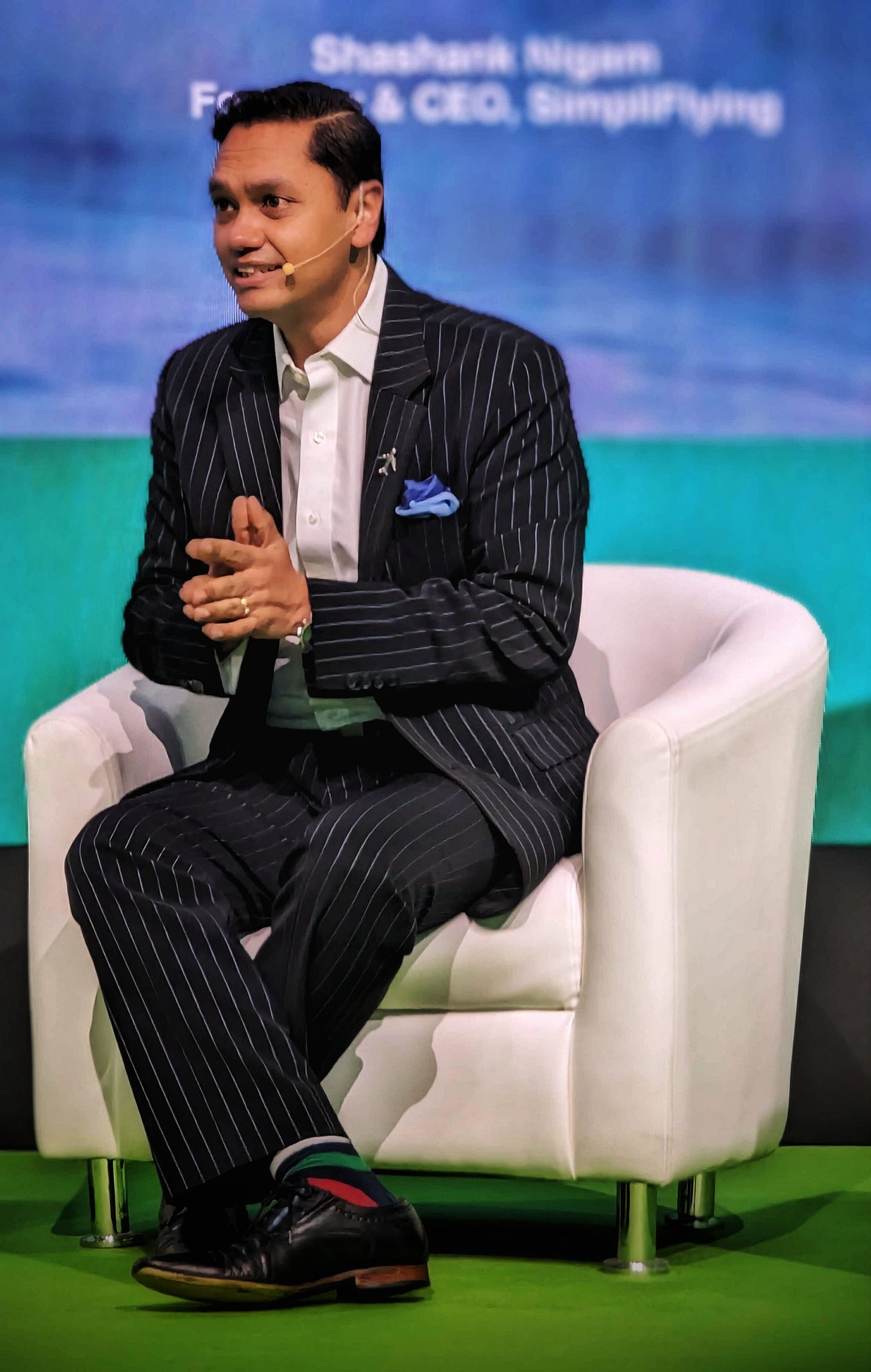Can aviation growth be reconciled with decarbonisation? An industry panel takes stock
The panel at the Arabian Travel Market (ATM) was hosted by SimpliFlying's Shashank Nigam and featured Boeing's Brian Moran, Wizz Air's Yvonne Moynihan, and CarbonClick's Dave Rouse.
As well as hosting COP28 at the end of this year, the United Arab Emirates (UAE) is dependent on aviation, with airline and tourism accounting for 13% of the country’s GDP.
That makes it an ideal place to discuss how industry growth can be reconciled with decarbonisation. A panel today at the Arabian Travel Market (ATM) in Dubai did just that.
Hosted by SimpliFlying CEO Shashank Nigam, the session featured Boeing VP of Global Sustainability Policy and Partnerships Brian Moran; Yvonne Moynihan, Chief Corporate and ESG Officer at Wizz and CarbonClick CEO Dave Rouse.
Decoupling is key
According to Wizz Air’s Yvonne Moynihan, the key has to be to separate out growth from a reduction in emissions, so that the latter happens faster than the former - this is commonly known as decoupling.
Although Yvonne Moynihan said that Wizz Air had grown by 160%, it had so far succeeded in that decoupling challenge.
The airline’s A321neo aircraft are newer and more fuel efficient, and with a maximum of 239 passengers inside, the per passenger carbon footprint is lower.
At the same time, being an Ultra Low Cost Carrier (ULCC), the airline, of course, has no business class. It also flies point-to-point rather than relying on a hub-and-spoke model.
According to Yvonne Moynihan, “we’re laser focused on the technologies that are available right now, so that we can help accelerate the pace of decarbonisation faster than growth. And right now, it’s working.”
At the same time, Wizz Air is also investing in the technologies of tomorrow. Wizz Air has made a £5 million investment in UK SAF company Firefly, which turns sludge into Sustainable Aviation Fuel. Meanwhile, the airline is also one of Airbus’s partners in developing hydrogen-powered aircraft in its ZEROe programme.
Boeing focuses on ‘SAF And’
Even though Boeing has done research into hydrogen, Boeing’s Brian Moran had some reservations about the viability of hydrogen for use in commercial aviation, pointing out that “the more you look at this challenge, the harder it seems to get.”
Because of the nature of the fuel and the infrastructure required, “handling hydrogen is hard, and airlines depend on quick turn times.”
Instead, Boeing’s focus was on what Brian Moran called ‘SAF And.’
The ‘and’ part involves looking into next-generation technologies, one example being the work done with NASA to build a truss-braced wing demonstrator aircraft.
However, the reality is that there are 23,000 commercial aircraft in service today. That number will only grow, and the typical lifespan of an aircraft can easily be 30 years.
Hence Boeing’s focus on working on technologies that can work on the planes we see in the skies today, along with an emphasis on Sustainable Aviation Fuel (SAF). As a result, Boeing is ensuring that by 2030, all of its aircraft can fly with 100% SAF.
Other Boeing sustainability initiatives include the ecoDemonstrator project, where different technologies have been tested out on a 787-10 Dreamliner.
Last week, the aircraft manufacturer announced that it is expanding the program to assess 19 additional technologies on a Boeing 777 ecoDemonstrator.
Finally, Brian Moran talked about Cascade. Launched at the 2022 Farnborough Air Show, this is a data modelling tool which looks at how emissions can be reduced on different flight routes through everything from operational efficiencies to electric propulsion.
The issues of trust and transparency
With SAF not yet available at scale, and with technologies like hydrogen flight still being in their infancy, many airlines use carbon offset programmes, such as that offered by CarbonClick (whose clients include Etihad and Air Tahiti Nui).
CEO Dave Rouse addressed why only a small minority of consumers take part in voluntary carbon offsetting programmes, saying that it ultimately comes down to an issue of trust.
Often they are presented with the choice to offset their flights after they’ve already been given the chance to pay for seats, baggage, car hire or hotels, making it look like just another ancillary revenue opportunity.
As a result, it needs to be shown to the consumer in a different way. Dave Rouse also highlighted the Air Tahiti Nui example of where every passenger dollar spent on offsets is matched by the airline, as a model that others might want to follow.
Then, related to trust is the issue of transparency. A lot of consumers don’t know where their money is going when they offset or how much difference it really makes. And so, there needs to be much more visibility on this point.
Finally, speaking as a pilot himself, Dave Rouse wondered if the industry wasn’t ignoring much of the “low-hanging fruit” that exists when it comes to reducing emissions. One example is streamlining air traffic control processes to reduce the times that aircraft wait to land.
Reasons for optimism
Concluding the panel session, SimpliFlying CEO Shashank Nigam talked about the 50 C-Level interviews he had conducted as part of the Sustainability in the Air podcast.
From that, “the one thing that gives me hope is that everyone is working towards a common goal, even though they may be taking different paths to get there.”
The panel was another illustration of this ‘different paths / one goal’ approach. CarbonClick is focusing on adding trust and transparency into the offsetting market, Boeing has an aircraft testing new technologies and a data modelling tool, while Wizz Air is investing in SAF and looking ahead to hydrogen.
Finally, another reason for hope is that ten years ago, practically no one working in sustainable aviation was doing so. But now, you have a lot of minds and talents focused on making it a reality, and with climate change being of huge importance to young adults in particular, that will only grow.





